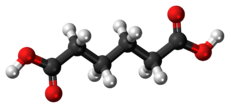Adipic acid
 |
|
 |
|
| Names | |
|---|---|
|
Preferred IUPAC name
Hexanedioic acid
|
|
| Other names
Adipic acid
Hexane-1,6-dicarboxylic acid Hexane-1,6-dioic acid |
|
| Identifiers | |
|
124-04-9 |
|
| 3D model (Jmol) |
Interactive image Interactive image |
| ChEBI |
CHEBI:30832 |
| ChEMBL |
ChEMBL1157 |
| ChemSpider |
191 |
| ECHA InfoCard | 100.004.250 |
| EC Number | 204-673-3 |
| E number | E355 (antioxidants, ...) |
| KEGG |
D08839 |
| PubChem | 196 |
| RTECS number | AU8400000 |
| UNII |
76A0JE0FKJ |
|
|
|
|
| Properties | |
| C6H10O4 | |
| Molar mass | 146.14 g·mol−1 |
| Appearance | White crystals |
| Odor | Odorless |
| Density | 1.360 g/cm3 |
| Melting point | 152.1 °C (305.8 °F; 425.2 K) |
| Boiling point | 337.5 °C (639.5 °F; 610.6 K) |
| 14 g/L (10 °C) 24 g/L (25 °C) 1600 g/L (100 °C) |
|
| Solubility | Very soluble in methanol, ethanol soluble in acetone slightly soluble in cyclohexane negligible in benzene, petroleum ether insoluble in acetic acid |
| log P | 0.08 |
| Vapor pressure | 0.0728 Pa (18.5 °C) |
| Acidity (pKa) | 4.43, 5.41 |
| Viscosity | 4.54 cP (160 °C) |
| Structure | |
| Monoclinic | |
| Thermochemistry | |
|
Std enthalpy of
formation (ΔfH |
−994.3 kJ/mol |
| Hazards | |
| Safety data sheet | External MSDS |
|
EU classification (DSD)
|
Irritant (Xi) |
| R-phrases | R36 |
| NFPA 704 | |
| Flash point | 196 °C (385 °F; 469 K) |
| 422 °C (792 °F; 695 K) | |
| Lethal dose or concentration (LD, LC): | |
|
LD50 (median dose)
|
3600 mg/kg (rat) |
| Related compounds | |
|
Related dicarboxylic acids
|
glutaric acid pimelic acid |
|
Related compounds
|
hexanoic acid adipic acid dihydrazide hexanedioyl dichloride hexanedinitrile hexanediamide |
|
Except where otherwise noted, data are given for materials in their standard state (at 25 °C [77 °F], 100 kPa).
|
|
|
|
|
| Infobox references | |
Adipic acid or hexanedioic acid is the organic compound with the formula (CH2)4(COOH)2. From an industrial perspective, it is the most important dicarboxylic acid: About 2.5 billion kilograms of this white crystalline powder are produced annually, mainly as a precursor for the production of nylon. Adipic acid otherwise rarely occurs in nature.
Adipic acid is produced from a mixture of cyclohexanol and cyclohexanone called "KA oil", the abbreviation of ketone-alcohol oil. The KA oil is oxidized with nitric acid to give adipic acid, via a multistep pathway. Early in the reaction the cyclohexanol is converted to the ketone, releasing nitrous acid:
Among its many reactions, the cyclohexanone is nitrosated, setting the stage for the scission of the C-C bond:
Side products of the method include glutaric and succinic acids. Nitrous oxide is produced as well, via the intermediacy of a nitrolic acid.
Related processes start from cyclohexanol, which is obtained from the hydrogenation of phenol.
Several methods have been developed by carbonylation of butadiene. For example, the hydrocarboxylation proceeds as follows:
Another method is oxidative cleavage of cyclohexene using hydrogen peroxide. The waste product is water.
Historically, adipic acid was prepared by oxidation of various fats, thus the name (ultimately from Latin adeps, adipis – "animal fat"; cf. adipose tissue).
...
Wikipedia

